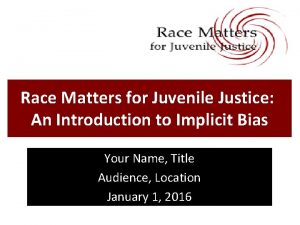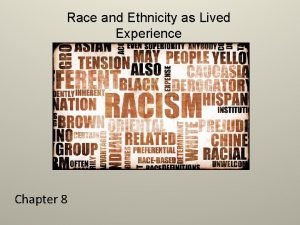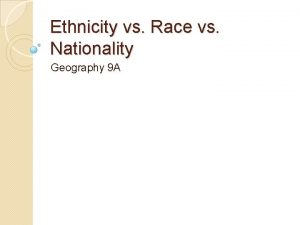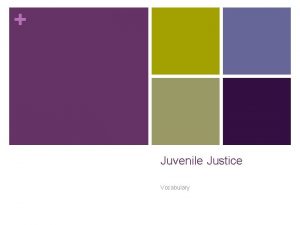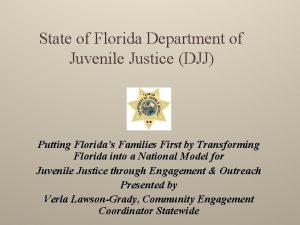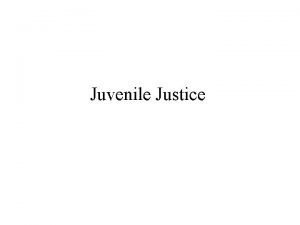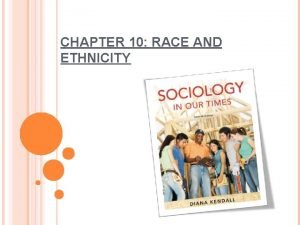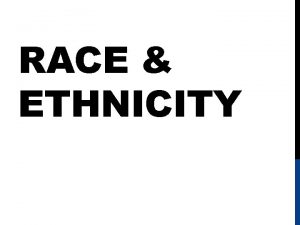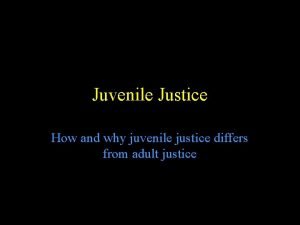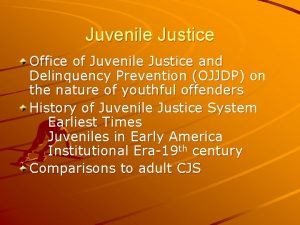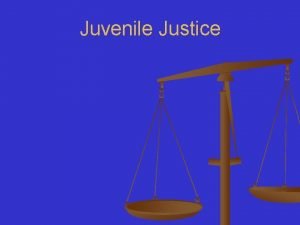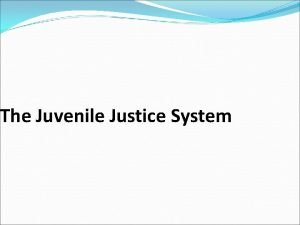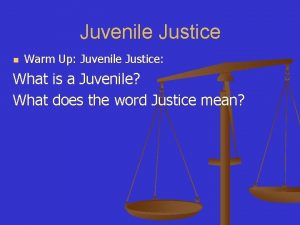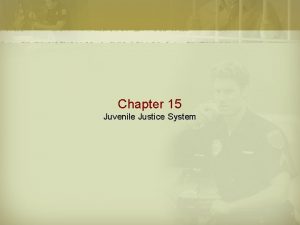Race and Ethnicity Path Through the Juvenile Justice


















- Slides: 18

Race and Ethnicity: Path Through the Juvenile Justice System Deputy Commissioner Joyce Burrell March 2008 NYS Office of Children & Family Services

Disproportionality § Disproportionality exists when a group makes up a proportion of those experiencing some event (e. g. , arrest or placement in OCFS facility) that is higher or lower than that group’s proportion in the population NYS Office of Children & Family Services

Race/Ethnic Distribution in Juvenile Justice System, 2006 New York City NYS Office of Children & Family Services

Race/Ethnic Distribution in Juvenile Justice System, 2006 Rest of State Mutually exclusive race/ethnic categories not available NYS Office of Children & Family Services

Black and Hispanic Youth are Overrepresented in Juvenile Justice System § In both NYC and Rest of State (ROS), black and Hispanic children make up a substantially higher percentage of the juvenile justice population at each stage in the process than their share of the general population of children under 16. NYS Office of Children & Family Services

Rate of Children Arrested, Admitted to Detention, Placed With OCFS, and In Care Per 1, 000 Children < 16 in Population 40 36. 2 NYS Office of Children & Family Services

Rate of Children Arrested, Admitted to Detention, Placed With OCFS, and In Care Per 1, 000 Children < 16 in Population 120 | 112. 3 40. 9 White arrest rate not reported because white arrests not mutually exclusive of Hispanic arrests NYS Office of Children & Family Services

Rates of Arrests, Detention, Placement, and In Care Highest for Black Children § As measured by rate per 1000 children in population, black children are more likely than Hispanic children, and Hispanic children are more likely than white children, to be arrested, admitted to detention, admitted to OCFS facilities and voluntary agencies, and in care. § Black and Hispanic children in ROS are arrested at more than twice the rate of NYC black and Hispanic children, and are detained at almost twice the rate of NYC black and Hispanic children. NYS Office of Children & Family Services

Disparity Rate Index Disparity refers to the lack of equality among racial/ethnic groups in the likelihood of being arrested, admitted to detention, admitted to OCFS facilities and voluntary agencies, and in care. The Disparity Rate Index (DRI) is the ratio of rate per 1000 for black (or Hispanic) children relative to rate for white children. Facility Admission Race/ Ethnicity Rate per 1, 000 Children in NYC Black 1. 241 White Black Disparity Rate 1. 241 0. 070 = 31. 8 0. 070 NYS Office of Children & Family Services

Disparity Rates for Black and Hispanic Children (Versus White Children) at Different Stages of Juvenile Justice System, 2006 NYS Office of Children & Family Services

Disparity Rates for Black and Hispanic Children (Versus White Children) at Different Stages of Juvenile Justice System, 2006 Disparity rates are not reported for arrests because mutually exclusive racial/ethnic categories not available for arrests NYS Office of Children & Family Services

Disparity Rate Findings § Disparity rates are very high for both black and Hispanic children, but are more pronounced for black children across all stages of the juvenile justice system. § Black and Hispanic disparity rates are considerably higher in NYC than in ROS at every point in the system except for voluntary agency admissions. § In NYC, black children are 31. 8 times as likely, and Hispanic children are 16. 4 times as likely, as white children to be placed in OCFS facilities. In contrast, in ROS, black children are 11. 5 times likelier and Hispanic children are 4. 8 times likelier than white children to be admitted to facilities. NYS Office of Children & Family Services

Relative Rate Index The Relative Rate Index (RRI) compares the rate of activity (number of events) in a given stage of the juvenile justice system to the rate of activity in a preceding stage, for black and Hispanic children relative to white children. Race/ NYC Ethnicity Arrests Black 6984 NYC OCFS Facility Admissions 421 White 966 11 Rate per 1, 000 Arrests 60. 281 11. 387 Black Relative Rate Index 60. 281 = 5. 3 11. 287 NYS Office of Children & Family Services

Disparity Rate Index Compared to Relative Rate Index for OCFS Admissions New York City NYS Office of Children & Family Services

Relative Rate Index is Much Lower Than Disparity Rate Index for Both Blacks and Hispanics in NYC § Although black children in NYC are 31. 8 times as likely as white children to be admitted to facilities and 16. 4 times as likely to be admitted to voluntary agencies, black children who are arrested are only 5. 3 times as likely as white children who are arrested to be placed in facilities and 2 times likelier to be placed in voluntary agencies. § While disparity rates are substantially lower for Hispanics than blacks, the Hispanic RRI is similar to the black RRI for both facility admissions (5. 5) and voluntary agency admissions (2. 2). That is, when the rate of arrest is taken into account, Hispanics have about the same likelihood as blacks of being placed in a facility or voluntary agency, relative to whites. NYS Office of Children & Family Services

What Does the Relative Rate Index Tell Us? § A large portion of the disparity in the rate at which black and Hispanic children are admitted to facilities and voluntary agencies compared to white children is introduced at point of arrest. That is, blacks and Hispanics are far more likely than whites to be arrested, and therefore, are more likely to be placed with OCFS. § However, even when the higher arrest rates for blacks and Hispanics are considered, blacks and Hispanics have a noticeably higher likelihood of being admitted to facilities and voluntary agencies than whites. This indicates that some disparity continues to occur later in the process, at adjudication or sentencing. NYS Office of Children & Family Services

New York City Juvenile Delinquents Admitted to OCFS Facilities in CY 2004: Cumulative Proportion Released to Community Over Time In NYC, Black and Hispanic juvenile delinquents are released from OCFS facilities at about the same rate as white juvenile delinquents. NYS Office of Children & Family Services

Rest of State Juvenile Delinquents Admitted to OCFS Facilities in CY 2004: Cumulative Proportion Released to Community Over Time In ROS, Black and Hispanic juvenile delinquents are released from OCFS facilities at about the same rate as white juvenile delinquents. NYS Office of Children & Family Services
 Race matters for juvenile justice
Race matters for juvenile justice Chapter 8: race and ethnicity as lived experience
Chapter 8: race and ethnicity as lived experience Definition of race and ethnicity
Definition of race and ethnicity Race vs ethnicity vs nationality
Race vs ethnicity vs nationality Criminal law and juvenile justice unit 2
Criminal law and juvenile justice unit 2 Republic act 9344
Republic act 9344 Difference between impulse and reaction turbine
Difference between impulse and reaction turbine A solid barrier constructed at a suitable location
A solid barrier constructed at a suitable location Juvenile delinquency vocabulary words
Juvenile delinquency vocabulary words State of florida department of juvenile justice
State of florida department of juvenile justice Expulsion
Expulsion Georgia juvenile justice system
Georgia juvenile justice system Juvenile justice act 2000
Juvenile justice act 2000 North carolina juvenile justice process
North carolina juvenile justice process Juvenile justice system in georgia
Juvenile justice system in georgia Coalition for juvenile justice
Coalition for juvenile justice Minnesota juvenile justice system
Minnesota juvenile justice system Data race vs race condition
Data race vs race condition Unity signalr
Unity signalr
